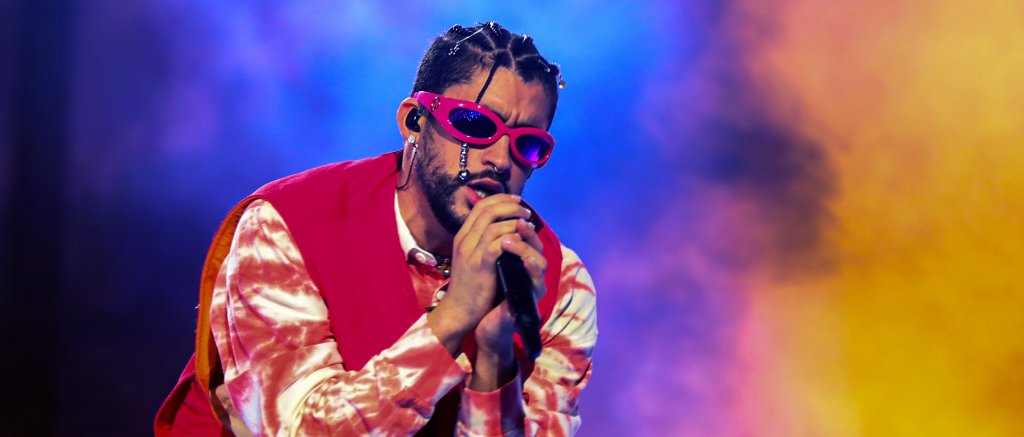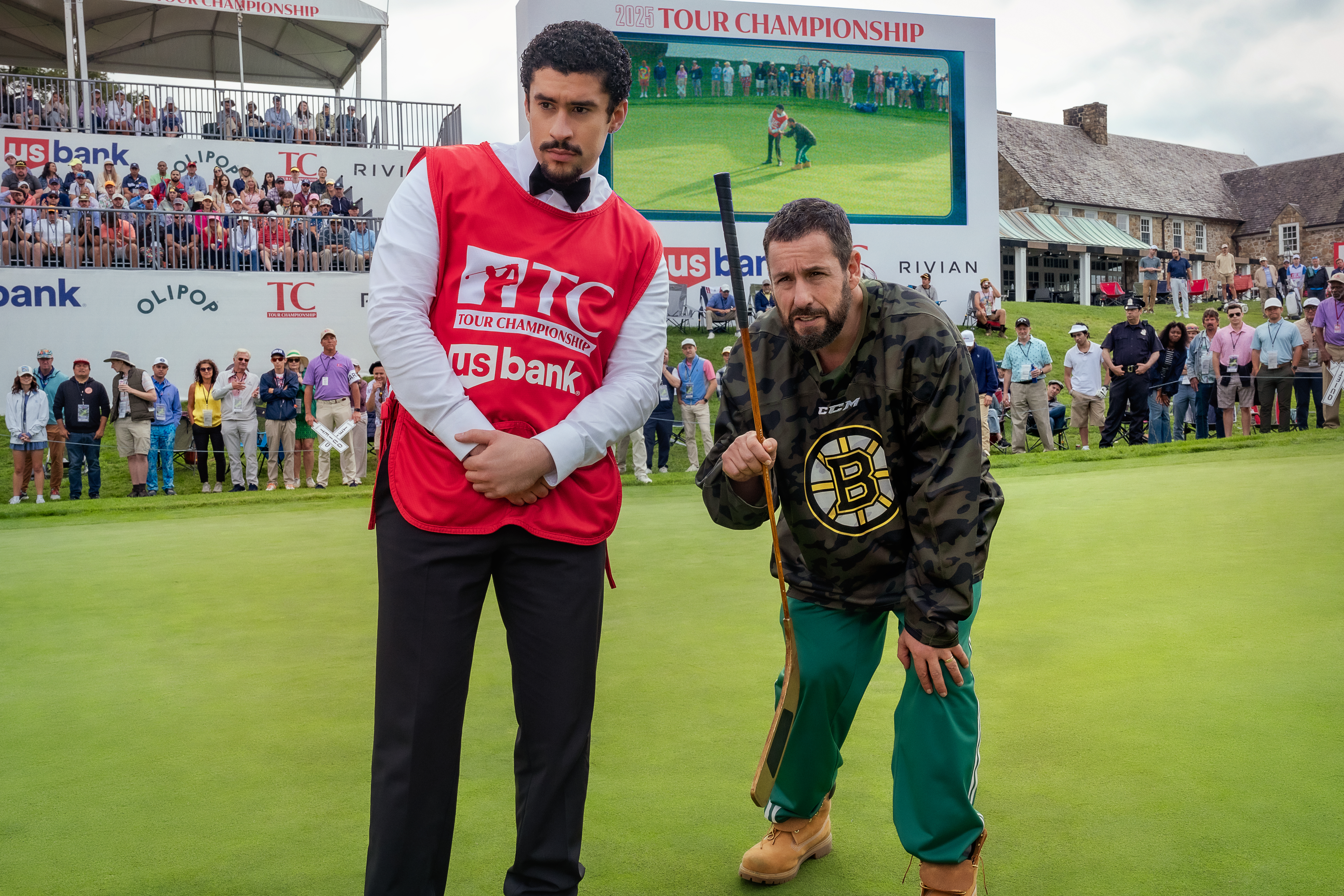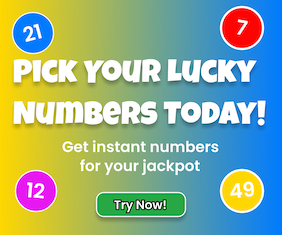Long before landing his first feature film credit, Bad Bunny was already performing. Not just onstage, where his undeniable charisma often feels larger than the stadiums he routinely sells out, but in music videos that played like short-form films and fashion editorials that doubled as character studies; in the melodrama of a WWE wrestling ring and the breakneck whirlwind of a legacy late-night sketch series. He was stretching muscles and toying with personas that should’ve hinted he’d one day end up on the big screen – though that first glimpse coming via a knife-flinging contest with an Academy Award-winner in a high-speed action thriller probably wasn’t on anyone’s Bingo card.
Admittedly, the first time I saw Bad Bunny – born Benito Antonio Martínez Ocasio – in theaters as he sauntered into Bullet Train, bloodied and brooding in a white tux, I seesawed between shock and skepticism. Here was one of the biggest music stars on the planet, fresh off redefining reggaetón for a new gen of music fans who preferred their lyrics bilingual and their Latin pop stars unapologetically authentic, tussling with Brad Pitt in a Japanese bar car. Was it a joke? A bit of stunt casting? A pop star cameo designed to boost box office numbers? The longer the camera lingered, the more stylishly violent the action became, a strange realization occurred: Bad Bunny is acting. Like, actually acting. With rage, with restraint, and with a little bit of camp. His howling assassin was a bright spot of the film, a teaser for his abilities on-screen and a continuation, not the beginning, of his expanding artistic pursuits.
From streaming hits on Netflix to Queer biopics and Darren Aronofsky-directed crime thrillers, Bad Bunny has been building something unusual for a pop star, especially one of his caliber: a real acting career, filled with risks that just might pay off.
Wigs, Wrestling, and Wild Visuals: Bad Bunny’s Road to the Big Screen

To be fair, Bad Bunny has never played it safe. From the beginning, he’s treated pop stardom like an evolving performance piece. He tore through Latin trap and reggaetón with genre-breaking albums like X 100pre and YHLQMDLG while redefining masculinity in the mainstream, using his style, his art, and his albums to push back on Machismo culture, almost effortlessly. That same trailblazing energy ran through his music videos, too, mini-films that felt less like promos and more like an artist playing in a sandbox of his own making.
In “Yo Perreo Sola,” he interrogated gender and power; in “Safaera,” he threw narrative out the window in favor of wild, visual world-building. He made a 23-minute piece of powerful protest art with “El Apagón,” blended comedy with magical realism in “Tití Me Preguntó,” channeled ’80s telenovela aesthetics in “La Difícil,” and animated himself to become Homer Simpson’s life coach in “Te Deseo Lo Mejor.” There’s a reason Bad Bunny became the first non-English-language performer to win MTV’s VMA artist of the year title – his videos offer a kind of masterclass in experimental short-form storytelling. They’re also proof that his graduation to bigger film and TV projects has always been inevitable.
But Bad Bunny didn’t just dip a toe into the acting game; he jumped in the deep end, wearing prosthetics and green face paint and ridiculous wigs, all while a live audience watched transfixed. On Saturday Night Live, first as a musical guest in 2021 and later as host in 2023, the singer proved he could do more than just read cue cards. He committed – playing weird, over-the-top caricatures and leaning into self-deprecating humor with surprising ease. As a villainous telenovela star with a horse-length ponytail, he hammed it up alongside Mick Jagger and SNL castmembers Marcello Hernandez, Mikey Day, Bowen Yang, and Punkie Johnson. He played an apologetic MC in an 8 Mile spoof, an overprotective aunt meeting her nephew’s white girlfriend for the first time, a childish king, a nun, an ogre… all while showing a natural feel for timing and a willingness to look ridiculous to earn a laugh.
Then came WWE, where he took another unexpected detour – into the ring. What started as a novelty guest appearance in 2021 turned into an on-the-ropes run, eventually leading to a high-profile WrestleMania moment. He trained for months, sold the hits, and won over wrestling purists with real physical commitment and theatricality. (No easy feat.) That same year, he made a short but memorable appearance in Narcos: Mexico as Arturo “Kitty” Páez, a flashy, wannabe gangster in the upper ranks of a drug cartel. He didn’t have a ton of screen time, but he didn’t need it. Critics (and fans) clocked the role as his first real dramatic turn, and an undeniable sign he had serious acting potential.
How Bad Bunny’s Movie Career is Rewriting Hollywood’s Playbook

Bad Bunny’s first real film test came with Bullet Train (2022), where he played The Wolf, a vengeful assassin with a tragic backstory. With just a handful of lines, raw physicality, and a killer glare, he made enough of an impression that fans began clamoring for a spinoff movie focused solely on his character’s criminal come-up. He followed that with a quieter, more intimate role in Cassandro (2023), playing the love interest of Gael García Bernal’s flamboyant lucha libre icon. The role challenged him to build on-screen chemistry with Bernal as his character struggled to define their relationship and his own sexuality. It was a subtle, tender performance – understated and emotionally grounded – that proved he could dial it down and still command our attention on-screen.
Which brings us to Happy Gilmore 2, where Bad Bunny surprised just about everyone with a sharp, hilarious turn that saw him stealing scenes from comedy legends like Adam Sandler, Christopher McDonald, and Ben Stiller. There’s an absurd level of confidence on display as his eager-to-please, by-the-book caddy slathers up NFL stars and delivers verbal Spanish beatdowns on the green. In a film meant to honor Sandler’s long career of building beloved characters, Bad Bunny became the sequel’s most memorable – and meme-able – star. But, an even bigger test is coming. Aronofsky’s Caught Stealing promises a gritty crime thriller complete with tonal whiplash and larger-than-life characters clawing for more screentime. With names like Austin Butler, Zoe Kravitz, Matt Smith, and Regina King, Bad Bunny will be tasked with holding his own against experienced heavyweights in an auteur-driven experiment that will likely demand more from him as an actor than ever before. Noir tones, physical danger, moral ambiguity: this might just be where Bad Bunny steps into full-on leading man territory.
That kind of pressure to pioneer a different pop-star crossover career seems to sit just fine with him, though. He isn’t following the industry playbook; he’s throwing it out, refusing to go the way of the Latin phenoms that came before. There’s no squeezing into typecasting. In many ways, Hollywood is coming to him, not the other way around. His ascendance signals a new era where global stars arrive fully formed, on their own terms, backed by audiences too big to ignore. His cinematic universe doesn’t just cement him as a multifaceted creative powerhouse; it proves he’s willing to blur boundaries to redefine our modern definition of what a music artist is. Excuse us while we grab our popcorn.

